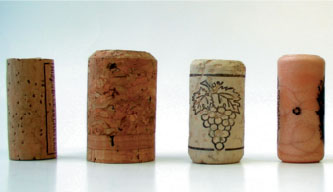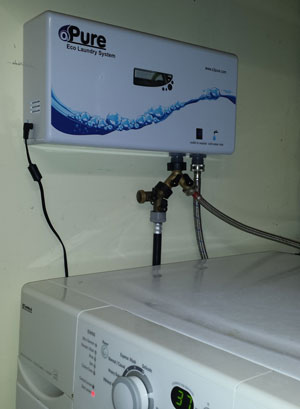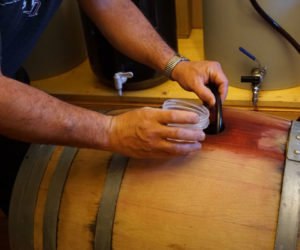Q
What are the pros and cons of using synthetic vs. natural vs. agglomerated corks? Is there a recommended cork for someone making about 100 gallons (380 L) of wine a year and should you sanitize the corks? We use sodium percarbonate to sanitize, but would you recommend something better?
John Battistini
Estell Manor, New Jersey
A
The choice of bottle closure is a topic that winemakers the world over debate with regularity. Every time a new bottle closure or packaging method comes out (twist off? Glass? Stainless steel kegs?) the pros and cons are trotted out, and for very good reason. Whether for function, form, or just for marketing purposes, there are many reasons why commercial winemakers (and for that matter, a winery’s marketing department) would choose one over the other. This is too widely ranging of a topic to treat thoroughly here so I’ll just stick to those closures that home winemakers are most likely to have available to them and to be using: Full natural corks, “1 + 1” agglomerated corks, 100% agglomerated corks, and synthetic corks.
Before I dive in, let me answer your last question about sanitizing corks. Most closures are packaged pre-sanitized, usually with sulfur dioxide in the sealed bags that come from the manufacturer. No commercial winery I’ve ever known soaks or sanitizes their corks before bottling because they buy closures in the thousands from reputable suppliers with high turnover and high quality control standards. Commercial wineries buy full bags in enough quantity to cover their current bottling, with minimum waste and leftovers. Wineries are sticklers for quality control and monitor their incoming corks for moisture content, TCA (trichloroanisole, or the “corked” aroma defect), cleanliness, and freshness — and they expect their cork suppliers to do the same.
It’s a little tougher to control your cork supply when you’re a home winemaker buying 100 corks at a time, maybe in plastic baggies, maybe (horrors!) just loose in a bin on a shelf. That’s when it’s critical to know your home winemaking supply shop owner personally. Be sure to ask him or her where their closures come from, how long the sealed bag from the manufacturer has been open and if the corks are from just one batch. A worst-case quality control scenario would be to have old corks, mixed up from multiple batches, stored for months open in the air. This would result in a cork that would most likely be dried up, hard to insert into the bottle, unable to properly re-expand back into the bottleneck for a tight seal and possibly contaminated with TCA-producing mold. This is what you want to avoid.
Luckily, if you don’t have a great relationship with your local home winemaking supply shop, you can go in with buddies and buy the highest-quality corks in 1,000 cork bags (that’s enough for 83 cases of wine) directly from the manufacturer. That way you’ll be most sure to get a cork with the correct moisture content, sanitized and stored in an SO2-gas environment as well as a batch tracking number in case you have problems crop up later and want to get back to the seller. If you get these kind of rock-solid corks, you don’t need to do any soaking, boiling, or sanitizing.
However, if you don’t have those above good options and don’t know much about your corks and what they’ve been exposed to, it might be a good idea to attempt to soak and sanitize them in a strong sulfite solution. Try mixing a 70 ppm sulfur dioxide solution with 1 g/L of tartaric acid (the acid makes the SO2 more effective) and giving the corks a quick dip. While I love sodium percarbonate (AKA “Peroxycarb”) as a cleaner/sanitizer for hard surfaces like stainless steel, do be aware that this is largely just to make you feel better, like you’re doing something to try to help; it’s unlikely that a sulfur dioxide solution, no matter how strong, will be able to penetrate into the pores of a cork and inhibit molds that may be lurking. Now let’s talk about the most common cork options available to home winemakers.
Full natural corks: Produced in varying lengths and sizes, these are the old stand-by “plug of cork oak bark” corks that have been around for over 300 years. Pros: Easy for home winemakers to find, usually very easy to insert, are very “springy,” fit back into the bottle neck nicely. Hold up well over time and are attractive to use and easy to extract with a traditional corkscrew. Can be branded with your wine’s name; the writing usually appears easy to read and crisp because of the lack of pores in the wood. Recyclable with “cork take-back” programs, like those promoted at Whole Foods, some wineries, and wine shops. Cons: Long and highest-quality corks are the most expensive cork option. A natural cork, of any kind, will always carry a small risk of TCA development.
“1+1” corks: These corks have a small disk of 100% cork at either end and either lower-quality, more porous cork in the middle or an aggregated cork pellet (cork bits held together by a plastic polymer, usually polyurethane) between them. Pros: More affordable than full natural corks, relatively good performance in insertion and extraction. Can also be branded (more like printed) with a logo or name, though sometimes the cork bits make it harder to read. Recyclable with “cork take-back” programs, like those promoted at Whole Foods, some wineries, and wine shops. Some claim that the full-cork disks, which are not as porous as the “particleboard” interior, protect the wine from the agglom-erated interior with its higher-possible incidence of TCA-promoting mold. Cons: Sometimes the endcap disks come off or detach upon uncorking the wine bottle. Naturally more porous than a highest-quality natural cork, will have higher chance for TCA-causing molds to inhabit the corks.
100% agglomerated corks: These are commonly used by commercial wineries for their cheapest wines as they are the most affordable “natural” cork option out there. They tend to be shorter (part of the reason they’re more affordable) and are made of cork bits held together by a polyurethane binder. They have all of the issues of the 1+1 corks (higher possible incidence of TCA causing fungi) with none of the (possible) protection of the full-cork disks. One exception to this rule is possibly the “Diam” agglomerated cork product which claims to be TCA-free due to a proprietary process. These are considerably more expensive than run of the mill agglomerated corks and I haven’t seen them in wide distribution in home winemaking supply stores. Pros: Cheapest natural-based closure available. Cons: Typically has the highest possible incidence of TCA. Some feel that it’s not as attractive or traditional as the full natural corks.
Synthetic cork: There are a few different products on the market; from completely solid plugs as well as spongier, extruded closures. Pros: Often are very affordable. Fun colors. Limitless possibilities for graphics. Very low possibility of TCA development. Some brands, like Nomacorc, claim to be fully recyclable. Nomacorc additionally has a “Bio” closure that is made from recyclable plant-based “biopolymer” derived from sugarcane. Cons: Often hard and difficult to insert into bottlenecks. Their hardness can make them prone to poor re-expansion in the bottleneck. Some extruded spongy products, in my own winery trials, have shown high incidence of free SO2 loss as well as high oxygen intrusion rates. Many feel that they are not as attractive or traditional-looking as full natural corks. In my years of personal experience (I have not yet tried the Nomacorc “Bio” product since it’s so new) I do not recommend synthetic corks as for me, the cons outweigh the pros.
So there you have it, a quick rundown on my thoughts on closure choice. Of course there are twist offs and the glass “Vinoseal” (AKA “Vino-lok”) closure and even a crazy plastic one called the “Zork.” Unfortunately, most of these sealing methods require special bottling line machinery and closure-specific glass with specifications that will work with these more specialist type closures. None are easy to do from a home winemaking perspective, except Zorks. However, with TCA being an ongoing problem (and TCA can come from other sources in the winery besides cork, by the way) and with technology always evolving, there’s no question we will always be having the great cork debate.
Q
I have harvested Petit Verdot grapes and crushed/destemed them. Before pitching the yeast the pH was between 3.6 and 3.7. The titratable acidity (TA) was not tested then. Once the fermentation is done, can I test the TA and if low, can I adjust it with tartaric acid? I do know that by adding tartaric acid it can decrease the pH or run the risk of making it increase. I have a feeling that it is going to be low, like 0.40. I don’t know the best range for the pH and TA for Petit Verdot. The fermentation has been active and no issues with a temperature of about 72 °F (22 °C). Do you have any suggestions? This is my first time making this variety. I used Red star Pasteur red yeast. The Brix was 20 and I added sugar to bring it up to 22.5.
Patricia Bohannon
Blue Ridge, Virginia
A
You certainly can adjust acidity after fermentation is complete, but many winemakers feel that the acid is better-integrated, as well as less-detectable, the earlier it is added. That being said, by all means measure the total acidity after fermentation (and after malolactic fermentation) and feel free to adjust as you’d like. Indeed, adding tartaric acid will shift the pH down (more acidic). Looking at your wine’s numbers above, I’m guessing that post-malolactic fermentation you ended up with a pH in the range of 3.75–3.85, depending on the amount of malic acid in the grapes. Your grapes don’t strike me as being particularly ripe, so be sure you do bench trials on your finished wine in order to check that you’re not over-adding. The great thing about home winemaking is that sometimes the best thing to do (adjust based on taste) is the easiest as well. Too much added tartaric acid can make your wine taste harsh, sharp, and tart. Acid also has the tendency to emphasize tannins; if your wine was green or unripe tasting in any way be careful not to add too much.
If you have access to a pH meter you can do step-wise bench trials to see how a specific measured tartaric acid addition affects your wine. My gut feel is that you may like a 0.25-0.30 g/L addition of tartaric acid but be sure to add in increments to make sure you like the results. Just be sure you use tartaric acid. Malic acid, of course, will just get consumed by malolactic bacteria and will disappear, whereas citric acid can actually be used as a food source by some wine organisms so its use as an acidifier is always risky.







